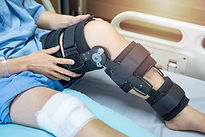
ACL/MCL
-
High-impact sports like soccer, football, and basketball carry a high risk of ACL (Anterior Cruciate Ligament) and MCL (Medial Collateral Ligament) injuries from sudden stops, pivots, and collisions.
-
Typical injuries include ligament sprains, partial tears, and full ruptures.
-
Key risk factors: prior knee injuries, poor landing mechanics, weak hip/core muscles, and overtraining.
-
Neuromuscular training, strength, balance, and agility exercises can reduce ACL injury risk by up to 67%.
-
ACL injuries affect over 200,000 athletes annually in the U.S. alone.
Signs and Symptoms
Immediate Care (RICE Method)
-
Rest: Stop activity immediately; use crutches if needed.
-
Ice: 20 mins on, 1 hour off (first 48 hours).
-
Compression: Use elastic bandage (not too tight!).
-
Elevation: Keep knee above heart level.
When to See a Doctor
-
Inability to walk
-
Knee “gives out”
-
Severe swelling within 2 hours
Professional Treatement

Non-Surgical:
Physical therapy (6–12 weeks)
Bracing
Surgical:
ACL reconstruction (patellar tendon graft)
Post-op rehab (6–9 months)
Prevention Strategies
1. Strength Training:
-
Focus on hamstrings, quads, glutes
2. Neuromuscular Training:
-
Plyometrics (box jumps, single-leg hops)
3. Gear Recommendations:
-
Knee braces (e.g., DonJoy Armor)
-
Proper footwear (ankle support)
